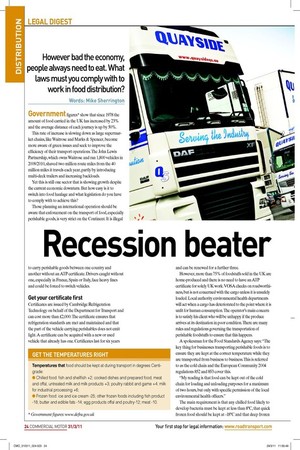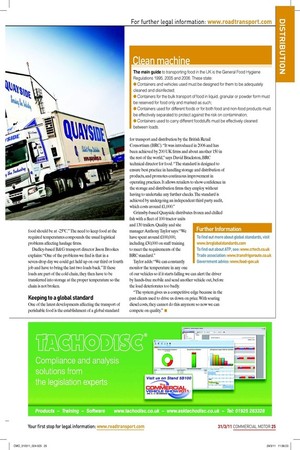Recession beater
Page 17

Page 18

If you've noticed an error in this article please click here to report it so we can fix it.
However bad the economy, people always need to eat. What laws must you comply with to work in food distribution?
Words: Mike Sherrington Government igures* show that since 1978 the amount of food carried in the LTK has increased by 23% and the average distance of each journey is up by 50%.
This rate of increase is slowing down as large supermarket chains, like Waitrose and Marks & Spencer, become more aware of green issues and seek to improve the eficiency of their transport operations. The John Lewis Partnership, which owns Waitrose and ran 1,800 vehicles in 2009/2010, shaved two million route miles from the 40 million miles it travels each year, partly by introducing multi-deck trailers and increasing backloads.
Yet this is still one sector that is showing growth despite the current economic downturn. But how easy is it to switch into food haulage and what legislation do you have to comply with to achieve this?
Those planning an international operation should be aware that enforcement on the transport of food, especially perishable goods, is very strict on the Continent. It is illegal to carry perishable goods between one country and another without an ATP certiicate. Drivers caught without one, especially in France, Spain or Italy, face heavy ines and could be forced to switch vehicles.
Get your certificate first
Certiicates are issued by Cambridge Refrigeration Technology on behalf of the Department for Transport and can cost more than £2,000. The certiicate ensures that refrigeration standards are met and maintained and that the part of the vehicle carrying perishables does not emit light. A certiicate can be acquired with a new or used vehicle that already has one. Certiicates last for six years and can be renewed for a further three.
However, more than 75% of foodstuffs sold in the LTK are home-produced and there is no need to have an ATP certiicate for solely LTK work. VOSA checks on roadworthiness, but is not concerned with the cargo unless it is unsafely loaded. Local authority environmental health departments will act when a cargo has deteriorated to the point where it is unit for human consumption. The operator’s main concern is to satisfy his client who will be unhappy if the produce arrives at its destination in poor condition. There are many rules and regulations governing the transportation of perishable foodstuffs to ensure that this happens.
A spokesman for the Food Standards Agency says: “The key thing for businesses transporting perishable foods is to ensure they are kept at the correct temperature while they are transported from business to business. This is referred to as the cold chain and the European Community 2004 regulations 852 and 853 cover this.
“My reading is that food can be kept out of the cold chain for loading and unloading purposes for a maximum of two hours, but only with speciic permission of the local environmental health oficers.” The main requirement is that any chilled food likely to develop bacteria must be kept at less than 8°C, that quick frozen food should be kept at -18°C and that deep frozen food should be at -25ºC.” The need to keep food at the required temperatures compounds the usual logistical problems affecting haulage irms.
Dudley-based B&G transport director Jason Brookes explains: “One of the problems we ind is that in a seven-drop day we could get held up on our third or fourth job and have to bring the last two loads back.” If these loads are part of the cold chain, they then have to be transferred into storage at the proper temperature so the chain is not broken.
Keeping to a global standard
One of the latest developments affecting the transport of perishable food is the establishment of a global standard for transport and distribution by the British Retail Consortium (BRC). “It was introduced in 2006 and has been achieved by 200 UK irms and about another 150 in the rest of the world,” says David Brackston, BRC technical director for food. “The standard is designed to ensure best practice in handling storage and distribution of products, and promotes continuous improvement in operating practices. It allows retailers to show conidence in the storage and distribution irms they employ without having to undertake any further checks. The standard is achieved by undergoing an independent third party audit, which costs around £1,000.” Grimsby-based Quayside distributes frozen and chilled ish with a leet of 100 tractor units and 130 trailers. Quality and site manager Anthony Taylor says: “We have spent around £100,000, including £30,000 on staff training to meet the requirements of the BRC standard.” Taylor adds: “We can constantly monitor the temperature in any one of our vehicles so if it starts falling we can alert the driver by hands-free mobile and send another vehicle out, before the load deteriorates too badly.
“The system gives us a competitive edge because in the past clients used to drive us down on price. With soaring diesel costs, they cannot do this anymore so now we can compete on quality.” ■









































